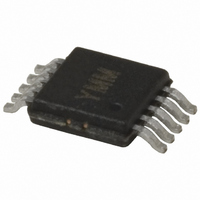MIC5190BMM Micrel Inc, MIC5190BMM Datasheet - Page 11

MIC5190BMM
Manufacturer Part Number
MIC5190BMM
Description
IC CTRLR LDO/FILTER HS 10MSOP
Manufacturer
Micrel Inc
Type
Positive Adjustabler
Datasheet
1.MIC5190YMM.pdf
(13 pages)
Specifications of MIC5190BMM
Number Of Outputs
1
Voltage - Output
Adjustable
Current - Supply
15mA
Voltage - Input
0.9 ~ 5.5 V
Operating Temperature
-40°C ~ 125°C
Package / Case
10-MSOP, Micro10™, 10-uMAX, 10-uSOP
Lead Free Status / RoHS Status
Contains lead / RoHS non-compliant
December 2005
Feedback Resistors
The feedback resistors adjust the output to the desired
voltage and can be calculated as follows:
V
voltage (R1=0) is 0.5V. For output voltages greater than 1V,
use the MIC5191.
The resistor tolerance adds error to the output voltage. These
errors are accumulative for both R1 and R2. For example, our
resistors selected have a 1% tolerance. This will contribute
to a 2% additional error on the output voltage.
The feedback resistors must also be small enough to allow
enough current to the feedback node. Large feedback resis-
tors will contribute to output voltage error.
For our example application, this will cause an increase in
output voltage of 12mV. For the percentage increase,
By reducing R1 to 100 , the error contribution by the feed-
back resistors and feedback current is reduced to less than
0.1%. This is the reason R1 should not be greater than 100 .
Applying the MIC5190
Linear Regulator
The primary purpose of the MIC5190 is as a linear regulator,
which enables an input supply voltage to drop down through
the resistance of the pass element to a regulated output
voltage.
MIC5190
REF
is equal to 0.5V for the MIC5190. The minimum output
V
V
V
V
V
V
V
ERROR
ERROR
ERROR
ERROR
ERROR
ERROR
OUT
V
REF
Figure 10. Adjustable Output
1k
12
R1 I
12mV
0 8
V
mV
1.5V
V
MIC5190
1
ERROR
OUT
FB
1
R2
R1
2
IR3716S
A
100
100
FB
R1
R2
COUT
GND
V
OUT
11
Active Filter
Another application for the MIC5190 is as an active filter on
the output of a switching regulator. This improves the power
supply in several ways.
First, using the MIC5190 as a filter on the output can signifi-
cantly reduce high frequency noise. Switching power sup-
plies tends to create noise at the switching frequency in the
form of a triangular voltage ripple. High frequency noise is
also created by the high-speed switching transitions. A lot of
time, effort , and money are thrown into the design of
switching regulators to minimize these effects as much as
possible. Figure 9 shows the MIC5190 as a post regulator.
Figure 11 shows the amount of ripple reduction for a 500 kHz
switching regulator. The fundamental switching frequency is
reduced from greater than 100mV to less than 10mV.
The transient response also contributes to the overall AC
output voltage deviation. Figure 12 shows a 1A to 10A load
transient. The top trace is the output of the switching regulator
(same circuit as Figure10). The output voltage undershoots
by 100mV. Just by their topology, linear regulators have the
ability to respond at much higher speeds than a switching
regulator. Linear regulators do not have the limitation or
restrictions of switching regulators which must reduce their
bandwidth to less than their switching frequency.
Figure 12. 10A Load Transient
Figure 11. Ripple Reduction
TIME (100 s/div)
TIME (1 s/div)
V
I
LOAD
OUT
= 1V
= 10A
M9999-120105
Micrel




